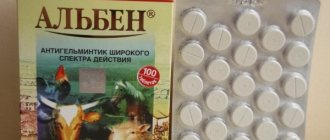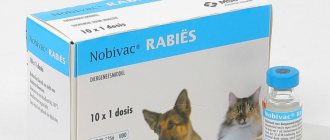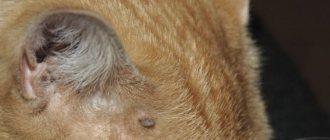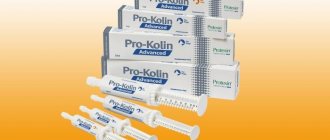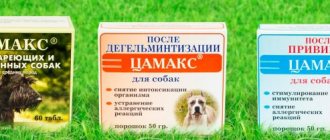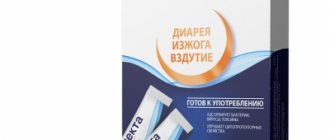General information about pimobendan
- Pimobendan has positive ionotropic and vasodilatory effects in dogs.
- Pimobendan is available in the form of vetmedin.
- For dogs with progressive dilated cardiomyopathy (DCM) or mitral and tricuspid valve endocarditis, pimobendan is used along with other cardiac medications such as ACE inhibitors, furosemide, or digoxin. Pimobendan should not be used as monotherapy.
- The drug is prescribed orally at a dose of 0.2 to 0.6 mg/kg per day, divided into two doses, every 12 hours.
- There are a number of side effects in dogs treated with the drug.
Pimobendan (Vetmedin, manufactured by Boehringer Ingelheim)
, a benzimidazole-pyridazinone derivative, is classified as an ionodilator due to its non-sympathomimetic, non-glycoside positive ionotropic effect (by stimulating calcium sensitization in the myocardium) and pronounced vasodilatory properties. Pimobendan increases left ventricular myocardial contractility and reduces preload and afterload in dogs with heart failure. Pimobendan has proven highly effective in the treatment of dogs with congestive heart failure secondary to endocardiosis of the atrioventricular heart valves or dilated cardiomyopathy.
Description and release form
The veterinary drug "Vetmedin" is a cardiotonic drug for dogs that is administered orally. This medicine is registered by WHO.
Available in the form:
- tablets of 500 mg, 1000 mg, 2000 mg. They have an oval shape and a break line in the middle, they are rough and brownish in color. There are also whitish inclusions, the manufacturer's logo and symbols. Packed in 50 or 100 pieces;
- capsules of 161 mg, 261 mg, 344 mg, 536 mg - gelatin capsules are available in the amount of 100 pieces in each package.
Important! When purchasing a pet, it would not hurt to find out what genetic diseases a particular breed is predisposed to. Thus, the following breeds are susceptible to diseases associated with insufficient cardiac activity: boxers, poodles, spaniels, English and French bulldogs, St. Bernards, collies, Dobermans, almost all small breeds
.
Packaged in plastic bottles with a screw cap. The bottles are stored in cardboard boxes on which the name of the drug, quantity, shape, weight of the tablet (capsule), active substance and its quantity, and manufacturer are written. There are also instructions for each form of the corresponding weight.
Pharmacology of pimobendan (vetmedin)
As stated above, pimobendan
is a derivative of benzimidazole-pyridazinone and has a positive ionotropic and vasodilating effect. Pimobendan has phosphodiesterase type III inhibitory activity similar to amrinone and milrinone. Phosphorylation of protein kinase is also stimulated, which activates l-type calcium channels and stimulates the sarcoplasmic reticulum to release a high concentration of calcium ions in the cytosol. This results in calcium binding to troponin C, which allows myosin to interact with actin, resulting in a positive ionotropic effect. This mechanism cannot fully explain the powerful ionotropic effect of pimobendan; there is obviously an alternative mechanism for increasing myocardial contractility.
The main mechanism of the ionotropic effect of pimobendan is the sensitization of the myocardium to calcium, which is apparently associated with an increase in the affinity of troponin C for calcium ions. Increased calcium binding to troponin C modulates actin and myosin polymerization and increases myocardial contractility. This positive ionotropic effect is achieved with only a slight increase in myocardial energy consumption. In other words, vetmedin practically does not change the consumption of ATP for myocardial contraction, while not increasing the risk of developing cardiac arrhythmia.
Pimobendan causes dilation of blood vessels and inhibits both type III and type V phosphodiesterase in the smooth muscle of the vascular wall. At the same time, the calcium concentration in smooth muscle cells decreases, unlike cardiomyocytes. Thus, pimobendan causes dilation of peripheral arterioles, dilation of coronary arteries, dilation of the pulmonary artery and peripheral veins.
After oral administration of pimobendan
, the absolute bioavailability of the active drug is from 60 to 63%. The half-life of the native drug is about 30 minutes, and the half-life of the main metabolite is about two hours. Most of the drug is excreted in the feces.
Personal prevention measures
When working with medicinal products, you should follow the general rules of personal hygiene and safety precautions provided for when working with medicinal products. At the end of work, hands should be washed with warm water and soap. In case of accidental contact of the drug with the mucous membranes of the eye, they must be rinsed with plenty of water. People with hypersensitivity to the components of the drug should avoid direct contact with Vetmedin. In cases of allergic reactions or if the drug accidentally enters the human body, you should immediately contact a medical facility (you should have the instructions for use of the drug or the label with you).
Manufacturer: Kloke Pharma-Service GmbH, Strassburger Str. 77, 77767 Appenweier, Germany.
Studies on the effectiveness of pimobendan (vetmedin) in dogs
Pimobendan
is safe and effective in dogs with mitral valve endocardiosis and dilated cardiomyopathy at a dose of 0.3 mg/kg PO every 12 hours. Clinical studies have demonstrated that Dobermanns with dilated cardiomyopathy were significantly more likely to survive when combined with vetmedin, digoxin, enalapril, and furosemide (median survival time, 329 days) than in patients treated with digoxin, enalapril, and furosemide alone (median survival time, 50 days). ) . These changes are statistically significant.
Preliminary studies in dogs with mitral valve regurgitation complicated by congestive heart failure have shown the effectiveness of pimobendan therapy. A six-month follow-up demonstrated that dogs receiving pimobendan and furosemide had fewer adverse outcomes (sudden cardiac death, death from progressive heart failure, or euthanasia) than dogs receiving an ACE inhibitor (ramipril) and furosemide. In addition, another study in dogs with chronic degenerative mitral valve disease complicated by congestive heart failure showed improved quality of life and survival in patients receiving vetmedin with or without furosemide compared with patients receiving an ACE inhibitor (benazepril) with or without furosemide. without furosemide.
General information
Trade name of the drug: Vetmedin tablets 5 mg . International nonproprietary name: pimobendan .
Dosage form: tablets. The tablets contain 5 mg of the active substance, pimobendan, and auxiliary components.
In appearance, the drug is a tablet.
The drug is packaged in blister packs of 100 tablets. Blisters are packed in individual cardboard boxes. Each box includes instructions for use.
The tablets are stored in the manufacturer's sealed packaging separately from food and feed in a dry place, protected from light, at a temperature of 8°C to 25°C. The shelf life of the drug, subject to storage conditions, is 3 years from the date of production. Do not use the drug after the expiration date. Tablets are stored in places inaccessible to children. Unused medicinal product is disposed of in accordance with legal requirements.
Use of pimobendan (vetmedin) in dogs
Indications for the use of pimobendan are the treatment of congestive heart failure caused by dilated cardiomyopathy or endocardiosis of the atrioventricular heart valves. Treatment begins in animals with pronounced symptoms of chronic congestive heart failure, for which the administration of positive ionotropes has good prospects. The range of dosages used is from 0.2 to 0.6 mg/kg daily divided into two doses every 12 hours. Each capsule should be administered orally one hour before meals, the drug should be in the capsule so as not to alter intestinal absorption. For treatment, the following vetmedin capsules are used - 1.25, 2.5 and 5 mg
. Therapeutic doses in dogs are higher than in humans. Thus, the relatively small size of the capsules is inconvenient for treating large and giant breed dogs. Treatment of dogs with pimobendan is very expensive.
Composition of the drug
The main active ingredient is pimobendan (indicated on the box). Its amount depends on the shape and weight of the drug.
Each tablet of different weights contains the corresponding mass of pimobendan:
- 500 mg - 1.25 mg pimobendan;
- 1000 mg - 2.5 mg;
- 2000 mg - 5 mg.
In capsules:
- 161 mg - 1.25 mg pimobendan;
- 261 mg - 2.5 mg;
- 344 mg - 5 mg;
- 536 mg - 10 mg.
All other contents are excipients.
Capsules contain: anhydrous citric acid, microcrystalline cellulose, anhydrous colloidal silica, povidone and magnesium stearate. The tablets have almost the same auxiliary fillers, only microcrystalline cellulose is replaced by croscarmellose sodium and maize starch, and there is also a meat-flavored additive. If you care for your pets, learn how to treat dogs with dandruff, chlamydia, epilepsy, eclampsia, Cushing's syndrome, pancreatitis, pyometra, staphylococcus, hip dysplasia, cutaneous, coronavirus and toxoplasmosis.
Use of pimobendan for dilated cardiomyopathy in dogs
Pimobendan
very effective in treating dogs with progressive forms of dilated cardiomyopathy. Patients with clinically significant forms of dilated cardiomyopathy have reduced left ventricular systolic function and ejection fraction. Their afterload increases as a result of dilatation of the left ventricle with insufficient hypertrophy of its walls and narrowing of arterioles (due to activation of the renin-angiotensin-aldosterone system and increased plasma concentrations of norepinephrine). This increase in afterload has a detrimental effect on left ventricular stroke volume and ejection fraction. By inhibiting phosphodiesterase types III and V, pimobendan promotes the dilation of both arterioles and veins. This reduces afterload and preload. However, myocardial phosphodiesterase inhibition by pimobendan appears to be attenuated in chronic severe dilated cardiomyopathy due to upregulation of beta receptors.
Pimobendan is prescribed to dogs with cardiomyopathy when overt or progressive heart failure develops. Clinical signs that indicate the development of heart failure include rim galloping, atrial fibrillation, shortness of breath, and nocturnal cough. Pulmonary vein dilatation on x-ray and echocardiography is also consistent with impending heart failure. Additional echocardiographic changes include increased pulmonary venous flow velocity and increased diastolic transmitral velocity during the early, rapid diastolic filling phase. In most cases, the positive ionotropic effect of pimobendan in dogs with dilated cardiomyopathy usually occurs within one week after the start of treatment, which can be confirmed using echocardiography.
Instructions for the use of vetmedin for mitral valve endocardiosis in dogs
Patients with myxomatous degeneration (endocardiosis) of the mitral valve have good contractility, as assessed by echocardiography, even when the left side of the heart is severely dilated. Thus, the ionotropic effect of pimobendan would seem to play a small role. However, the vasodilatory effect may help reduce afterload. For mitral valve endocardiosis, we add vetmedin in cases where clinically significant or progressive congestive heart failure develops while prescribing an ACE inhibitor, spironolactone, and amlodipine. According to owners, most dogs with obvious signs of heart disease begin to feel better (increased physical activity) within a few days after adding pimobendan to the basic treatment. Clinical improvement may not correlate with improvement in hemodynamic parameters. In these cases, pimobendan has an indirect systemic effect on the central nervous system, which helps improve physical and psychoemotional reactions in dogs with endocardiosis, as has been proven with other phosphodiesterase inhibitors (for example, pentoxifylline).
Pharmacological properties
Pimobendan has a positive inotropic and vasodilating effect. When taken, the force with which the heart contracts increases and the load on it decreases when heart failure is diagnosed.
After consumption, it is quickly absorbed and its availability to the body is about 60%. It breaks down fairly quickly and is excreted by the dog’s body, mostly in feces. It is a low-toxic medicine (class 4 according to GOST 12.1.007-76).
Interaction of vetmedin with other pharmacological drugs
Vetmedin
can be safely prescribed with diuretics, ACE inhibitors and digoxin. The slight vasodilatory effect of pimobendan combines well with a similar effect of ACE inhibitors. Potentiation of the vasodilatory effect of pimobendan should be expected when co-administered with nitrates (isosorbide dinitrate or nitroglycerin), amlodipine or carvedilol; severe hypotension, as a rule, does not develop. Improvement in cardiac function as a result of treatment with pimobendan may provide a slight reduction in the dosage of furosemide. The combined use of vetmedin with beta-blockers or calcium channel blockers may weaken the positive ionotropic effect of pimobendan, but enhance its vasodilatory effect.
Pimobendan can increase the rate of intestinal absorption of digoxin, but its concentration in the blood does not increase, and the risk of developing glycoside intoxication is low. Digoxin and pimobendan are prescribed for atrial fibrillation in dogs with progressive dilated cardiomyopathy. The combination of pimobendan with amiodarone or mexiletine is, in most cases, well tolerated in Boxers and Dobermans with severe dilated cardiomyopathy complicated by high-grade ventricular arrhythmias.
Precautions when using vetmedin
The effect of pimobendan has not been studied in pregnant and lactating dogs. Prescribing vetmedin to pregnant and lactating dogs is justified only if the potential benefits outweigh the potential risks. Although side effects are rare, polyuria, polydipsia, vomiting, diarrhea, and loss of appetite are possible. Pimobendan may increase the risk of developing arrhythmic syndrome, which may require simultaneous administration of antiarrhythmic drugs.
It is not advisable to prescribe vetmedin for early forms of dilated cardiomyopathy or endocardiosis of the atrioventricular heart valves. This leads to addiction, which can subsequently lead to decreased effectiveness in later stages of the disease. Digestive disorders in dogs are sometimes observed when vetmedin
.
Possible side effects
Provided Vetmedin's instructions are followed, side effects in dogs occur extremely rarely and go away without medical intervention. Can appear:
- tachycardia;
- nausea, stool upset, vomiting;
- apathy, lethargy, temporary loss of appetite;
- heart rate disturbances;
- physiological heart murmurs.
Expert opinion
Kuzmenko Olga Olegovna
Information about the expert
Ask a Question
For diarrhea and nausea, absorbents are used. If you feel unwell for a long time, you should consult a doctor, he will reduce the dose or select another drug.
Instructions for the use of pimobendan (vetmedin) in cats
The effectiveness of pimobendan in cats has been proven in recent multicenter randomized studies. Hypertrophic cardiomyopathy is the most common feline cardiomyopathy for which pimobendan has been shown to be effective in recent studies. Earlier studies found that for dilated cardiomyopathy, oral administration of pimobendan to cats in monotherapy at a dose of 0.6 mg/kg every 12 hours does not provide sufficient clinical effect, although no side effects were also found. Vetmedin should be prescribed with caution to cats suffering from obstructive forms of hypertrophic cardiomyopathy. The clinical effectiveness of pimobendan in cats still requires large-scale clinical and experimental studies.
^Top



